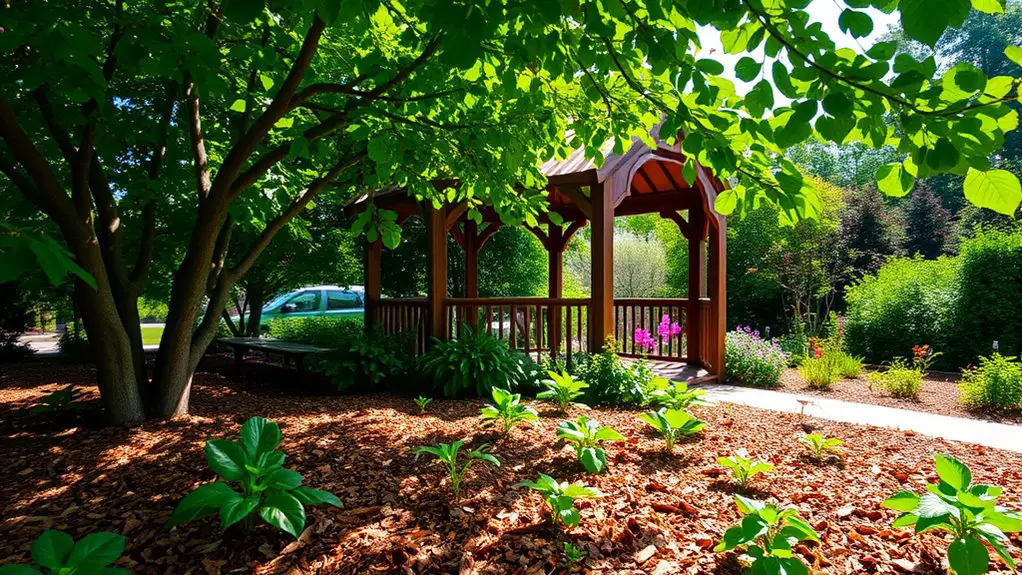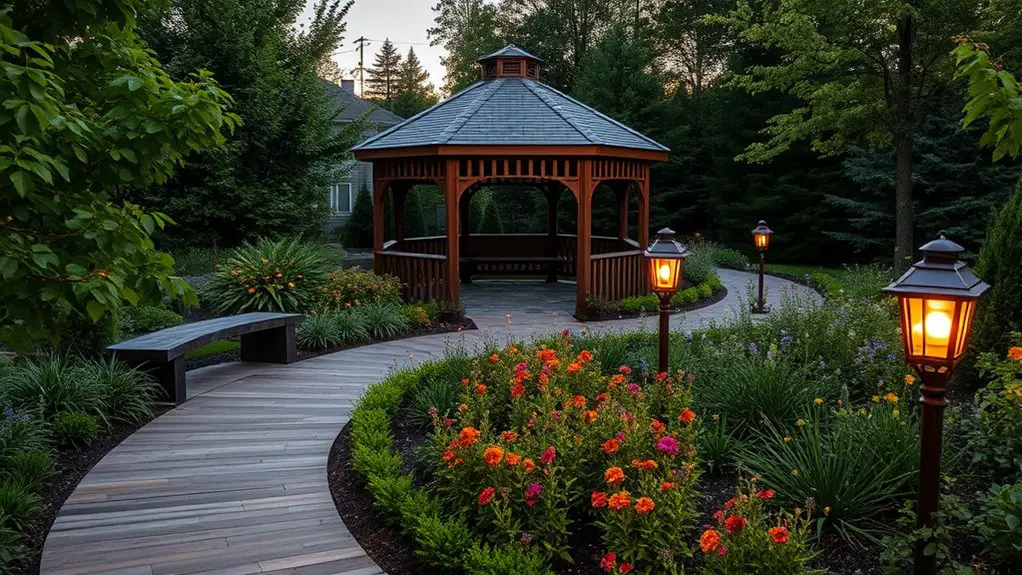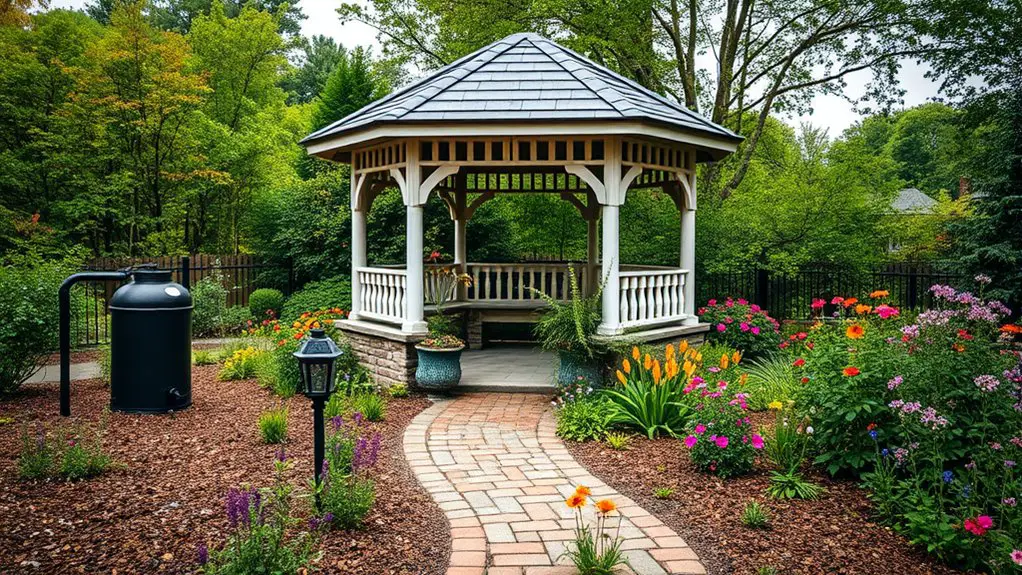To create a sustainable landscape for your gazebo, focus on native plants that need less water and enhance local ecosystems. Implement water-efficient irrigation systems, like drip irrigation and rain barrels, to conserve water. Utilize organic mulch to retain soil moisture and suppress weeds. Design for seasonal interest with diverse plant selections, and use sustainable hardscaping materials to minimize environmental impact. Creating wildlife habitats will enrich your space further. There’s plenty more to explore in enhancing your gazebo area!
Choosing Native Plants for Your Gazebo Landscape

When you’re designing the landscape around your gazebo, choosing native plants can greatly enhance both the aesthetic appeal and ecological health of your space. Native species are adapted to local conditions, making them resilient and often drought resistant varieties. This means less maintenance and less water consumption, which is essential for sustainable landscaping.
Incorporating pollinator friendly plants not only supports local ecosystems but also adds vibrant colors and textures to your landscape. Flowers like coneflowers, milkweed, and black-eyed Susans attract bees, butterflies, and other beneficial insects, creating a lively environment around your gazebo.
Implementing Water-Efficient Irrigation Systems
As you cultivate a sustainable landscape around your gazebo, implementing water-efficient irrigation systems can markedly reduce water usage while maintaining a healthy garden. To achieve this, consider the following approaches:
- Drip Irrigation: This system delivers water directly to the roots, minimizing evaporation and runoff. It’s efficient, conserving up to 50% more water than traditional methods.
- Rain Barrels: Collecting rainwater is a smart way to utilize natural resources. Position barrels beneath downspouts to gather runoff, ensuring you have a sustainable water source for your plants.
- Smart Controllers: These devices automatically adjust watering schedules based on weather conditions, preventing over- or under-watering. You’ll enjoy a vibrant garden without wasting resources.
Utilizing Organic Mulch for Soil Health

When you incorporate organic mulch around your gazebo, you’re not just enhancing aesthetics; you’re also fostering soil health. The benefits of organic mulch, such as moisture retention and nutrient enrichment, can transform your landscape into a thriving ecosystem. Let’s explore the various types of organic mulch that can optimize both the beauty and functionality of your outdoor space.
Benefits of Organic Mulch
Organic mulch serves as an essential component in enhancing soil health, offering numerous benefits that go beyond aesthetic appeal. By incorporating organic mulch into your landscaping, you can experience significant mulch benefits and promote soil improvement. Here are three key advantages:
- Moisture Retention: Organic mulch helps retain moisture in the soil, reducing the need for frequent watering.
- Nutrient Enrichment: As it decomposes, organic mulch adds crucial nutrients back into the soil, fostering healthy plant growth.
- Weed Suppression: A layer of organic mulch effectively inhibits weed growth, allowing your plants to thrive without competition.
Embracing these benefits not only leads to healthier soil but also supports a more sustainable and vibrant landscape around your gazebo.
Types of Organic Mulch
Choosing the right type of organic mulch can greatly impact soil health and the overall success of your landscaping efforts. Bark mulch, for instance, not only suppresses weeds but also retains moisture and breaks down slowly, enriching the soil over time. It’s perfect for aesthetic appeal around your gazebo, blending naturally with your environment. On the other hand, straw mulch is lightweight and ideal for gardens, providing excellent insulation and fostering beneficial microorganisms. It decomposes rapidly, enriching the soil but may require more frequent replenishment. By selecting the appropriate organic mulch, you’re not just enhancing your gazebo’s landscape, you’re also promoting a thriving ecosystem that empowers your plants to flourish, creating a harmonious balance between beauty and sustainability.
Promoting Biodiversity With Pollinator Gardens
To promote biodiversity in your gazebo’s landscape, consider incorporating pollinator gardens rich in native plants. By selecting a variety of flowering species, you not only attract essential pollinators but also enhance the ecosystem’s resilience. Implementing habitat creation techniques will further support these crucial creatures, fostering a thriving, sustainable environment.
Native Plant Selection
While many homeowners seek to create a visually appealing landscape around their gazebo, incorporating native plants not only enhances beauty but also promotes biodiversity, especially when designed as pollinator gardens. By selecting the right plants, you can foster a vibrant ecosystem. Consider these key elements:
- Pollinator Friendly Plants: Choose species like coneflowers and milkweed that attract bees and butterflies.
- Drought Resistant Species: Opt for plants such as lavender and salvia that thrive with minimal water, reducing maintenance.
- Seasonal Bloom Variation: Incorporate a mix of plants that flower at different times, ensuring a continuous food source for pollinators.
These strategies not only create a stunning landscape but also support essential wildlife, allowing you to enjoy a truly sustainable outdoor space.
Flowering Plant Diversity
Building on the foundation of native plant selection, flowering plant diversity plays an essential role in creating a thriving pollinator garden around your gazebo. By incorporating a variety of flowering plants, you enhance the ecosystem, attracting diverse pollinators such as bees, butterflies, and hummingbirds. Each species contributes unique flowering plant benefits, providing essential nectar and pollen throughout the growing season. Consider selecting plants with seasonal flowering patterns to guarantee continuous blooms, creating a feast for pollinators year-round. This not only boosts biodiversity but also promotes a vibrant, dynamic landscape that reflects the beauty of nature. Embracing flowering plant diversity empowers you to cultivate an inviting space that nurtures wildlife while enriching your outdoor experience.
Habitat Creation Techniques
Creating a vibrant pollinator garden around your gazebo requires thoughtful habitat creation techniques that enhance biodiversity. By incorporating diverse habitat types, you can attract a variety of pollinators and support local ecosystems. Here are three effective strategies:
- Native Plant Selection: Choose native flowers and shrubs that provide nectar and pollen throughout the seasons, ensuring a consistent food source for pollinators.
- Wildlife Corridors: Design your garden to connect with nearby green spaces, allowing pollinators to travel safely between habitats.
- Shelter and Nesting Sites: Integrate features like bee hotels and brush piles to offer shelter for various species, promoting a thriving ecosystem.
Designing for Seasonal Interest and Year-Round Appeal
To guarantee your gazebo remains a focal point throughout the year, it’s essential to design with seasonal interest in mind. Start by selecting plants that offer vibrant seasonal color, ensuring that each season brings its own palette. For spring, consider tulips and daffodils, while summer can burst forth with sunflowers and zinnias. Autumn’s hues can be captured with ornamental grasses and vibrant maples, and for winter, evergreens provide a year-round structure that stands strong against the elements.
Incorporate a variety of textures and heights to create visual interest, allowing your gazebo to blend harmoniously with the surrounding landscape. You might also add seasonal decorations or lighting to enhance its allure during special occasions. By thoughtfully curating your outdoor space, you not only celebrate nature’s cycles but also create an inviting environment that beckons you to enjoy your gazebo year-round. Additionally, a well-designed gazebo can significantly increase overall value of your property, making it a smart investment for homeowners.
Incorporating Sustainable Hardscaping Materials

While planning your gazebo’s surrounding hardscape, it’s essential to choose sustainable materials that not only enhance its beauty but also minimize environmental impact. By incorporating eco-friendly options, you can create a harmonious outdoor space. Consider these sustainable hardscaping materials:
- Recycled Materials: Utilize reclaimed bricks or stones for pathways and walls. They add character while reducing waste.
- Permeable Pavers: These allow water to filter through, reducing runoff and promoting groundwater recharge. They’re perfect for patios or driveways.
- Natural Stone: Opt for local, sustainably-sourced stone to minimize transportation emissions. It blends seamlessly with nature.
Managing Stormwater With Rain Gardens
As you design your gazebo’s landscape, integrating a rain garden can effectively manage stormwater, transforming runoff into a beautiful, functional feature. Rain garden design involves creating a shallow depression filled with native plants that absorb excess water, filtering pollutants and reducing erosion. This sustainable approach not only enhances your outdoor aesthetics but also plays a vital role in stormwater management.
By strategically placing your rain garden adjacent to the gazebo, you maximize its potential to capture runoff from hard surfaces, like patios and walkways. Select plants that thrive in wet and dry conditions, ensuring resilience while attracting pollinators.
Moreover, the natural infiltration process helps recharge groundwater, making your landscape more sustainable. With thoughtful design and placement, your rain garden becomes an eco-friendly haven, embodying the freedom of nature while addressing the practical challenge of stormwater. Embrace this innovative solution and watch your outdoor space flourish.
Creating Wildlife Habitats Around Your Gazebo
Creating a vibrant wildlife habitat around your gazebo not only enhances your outdoor space but also fosters ecological balance. By integrating specific elements, you can attract and support local wildlife, enriching your surroundings. Consider the following:
Enhance your gazebo’s charm while supporting local wildlife by creating a vibrant habitat with native plants, water features, and wildlife corridors.
- Plant Native Flora: Choose a variety of native plants that provide food and shelter, creating natural shelters for birds and small mammals.
- Build Wildlife Corridors: Design pathways of vegetation that connect your gazebo to other green spaces, allowing animals to move freely and safely.
- Incorporate Water Features: Add a small pond or birdbath to provide hydration and attract diverse species.
Frequently Asked Questions
How Do I Choose the Right Location for My Gazebo?
To choose the right location for your gazebo, consider sunlight exposure for warmth and light, while ensuring wind protection to enhance comfort. Analyze your yard’s layout creatively; this’ll help you achieve a perfect, inviting space.
What Types of Sustainable Furniture Can I Use Around My Gazebo?
Imagine your gazebo as a sanctuary. For eco-friendly seating, consider bamboo or reclaimed wood chairs. Pair them with recycled tables, creating harmony in nature. This choice reflects your commitment to sustainability while inviting freedom and joy.
How Can I Ensure My Gazebo Remains Eco-Friendly Over Time?
To guarantee your gazebo remains eco-friendly over time, focus on regular maintenance and apply natural treatments. These practices not only preserve its integrity but also promote a sustainable environment, allowing you to enjoy your space worry-free.
Are There Any Specific Pests to Watch for in a Gazebo Landscape?
Sure, you’d love to invite pests to your gazebo landscape, right? Instead, focus on smart pest control and thoughtful plant selection. You’ll keep your space thriving while avoiding unwanted guests that could ruin your enjoyment.
Can I Use Recycled Materials in Gazebo Construction?
Absolutely, you can use recycled materials in gazebo construction. Recycled wood offers durability, while eco-friendly metals enhance sustainability. Combining these materials not only reduces waste, but also adds character and individuality to your outdoor space.

